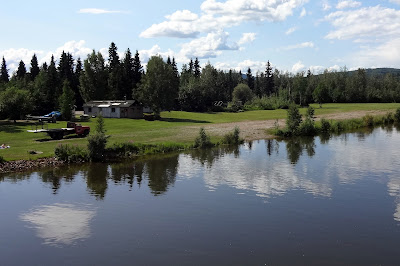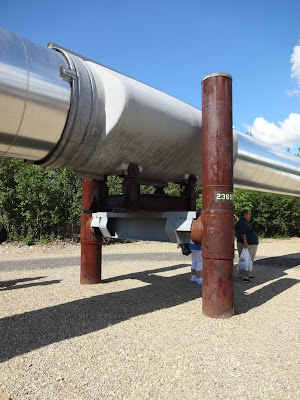We arrived at Fairbanks in the early evening after our train ride from Denali Park. As of 2010, the population of the city was 31,535, and the Fairbanks metropolitan area's population was 97,581. It is the second largest city in Alaska after Anchorage. Fairbanks is home to the University of Alaska, Fairbanks, the oldest of Alaska's colleges. I wish we could have gone there as the gardens there in summer are supposed to be fabulous with huge vegetables and flowers (that grow quite big because of the long days of sunlight during the short growing season) and a great museum.
I got a kick out of the vegetable garden in front of our hotel!
I took a walk to stretch my legs, discovering what was close to the hotel. There wasn't a lot. Six to 8 blocks away was the "downtown" area and a few restaurants including about 4 Thai ones. In a slightly different direction was the city Visitors' and Cultural center. It opened just a few years ago and had good reviews so I encouraged our small group to try to go there the next evening, the only time we had a bit of free time before leaving.
The next morning we paid for the continental breakfast before heading out on the Gold Dredge tour in the morning, following by a "typical" Alaskan lunch, and then went on a paddle boat river tour.
On our way to the Gold Dredge tour, we passed the dome below, left over from the early warning missile system from the 1950s and 1960s. Actually someone had bought this and put it there. Such domes used to be spread across Alaska and Canada, to warn of a Soviet attack.(Norad)
I was pretty disgusted by history of gold dredging. Yes, it did pay people's salaries. But it also tore up the land tremendously.
We heard the history of digging and then dredging, the latter being much more efficient. Water was needed and tons were piped in to provide the "lakes" needed. You can still see the path on the hill when the huge pipes were that brought the water from about 90 miles away.
 |
| Mechanical Gold Dredger |
 |
| Drawing of a dredger |
The mine we visited still was operating and making money.
It was fun to pan for gold. First we watched a demonstration. The sack of rocks and dirt is poured into the pan and then water is added. The told is heavier so sinks to the bottom and we rinse the dirt, etc. out.
We each were given a sack or sand and rocks from the area and were taught how to pan.
Here is a closer look:
 |
| The gold is weighed and I had $22 worth of gold! |
Since gold was about $1600 an oz., you can figure out how much I had. Another woman gave me her $4 worth for my grandsons!
Below you can see the largest nugget ever found in the Alaskan gold fields.
The nugget was on display in the huge gift shop where we had "plenty" of time to shop. There were also free cookies and coffee for those interested.
We mine was next to part of the pipeline. Part is underground and part is above, like the part here.
I was impressed to hear that is was built to withstand a 8.5 earthquake.
The pipe rests on supports, but it is not anchored to them so it can move with the earthquakes.
These H brackets were regularly spaced for the entire length of the pipeline above ground.
 |
| Howard and the pipeline |
We then were shuttled to another site by the river for lunch and a time to shop, of course, in the gift shop. The lunch was a meat stew and potato leek soup. They also had a salad we women could eat, rolls, and dessert. At the end of lunch, we heard the story of Lance Mackey, a guy has won the Iditarod 4 times. racer. His father was one of the founders of the Iditarod. He was diagnosed with throat cancer in 2001 but has
survived. The dogs saved his life. His story was compelling. The Holland America MC had a planned "conversation" with him that led to the promo of his book, The Lance Mackey Story a $25 book that I did NOT find on Amazon. You can read about him at: http://en.wikipedia.org/wiki/Lance_Mackey
After lunch, people could buy his book or pay $10 to have their photo taken with his puppies.
As you can tell, this day was quite "commercial," a stark contrast to the cruise.
Here is the Riverboat we traveled on during the Riverboat Discovery Tour. It could hold 800 and it had a lot of people on it this day. It was great for traveling on the shallow river as it only went down 3.5 feet into the river.
For most of the trip, we had narration and saw different things along the way. First we had a demo by a sea plane. These planes are still used today to bring people and things in and out of the area. In winter, the plane uses skiis and lands in snow or on ice. Nearby, there is still an airfield on grass that we saw also. The demo showed us how the plane can make quick turns and land on water.
Threre were lots of homes along the shoreline, most with quite a big of land around them.
 |
| landing strip is the "dirt" area |
 |
| Some homes were quite big |
Next, we had a demonstration by David Monson, Susan Butcher's widower. Susan was the most famous woman Iditarod racer, having won the Itidarod 4 times in the late 1980s and early 1990s. This family has been connected with this tour for a number of years, and their homestead is nearby. Her husband and daughter continue the association. We head about their dogs, saw some puppy training (being put in the end of a pond and getting out by themselves, and crawling over logs)
 |
| I got out of the water!!! |
and then saw the dogs pulling a tractor. So for those who had not seen dog racers before, this was a good introduction of about 15 minutes.
 |
| Dogs ran to the other side of the background water and back |
 |
| And they are off!! |
The dogs are not used to running in warm weather so after the run they headed to water to cool off!
You can read more about Susan Butcher at http://en.wikipedia.org/wiki/Susan_Butcher
She was born in Cambridge, MA, became a vet tech, and eventually followed her dream of dogsled reacing and breeding huskies and moved to Alaska.
She and her husband wrote a marvelous children's book about a runt pup named Granite who with a lot of courage went on to be in lead dog in 3 of her 4 wins.

After reading it, I did buy it and had the husband sign it for my 4 grandchildren.
If you have children or grandchildren, try getting this book from the library and reading it to them!
Our next "delight" was seeing caribou alongside the river. Yes, they were "planted" there but they were living in fairly natural surroundings.
 |
| On-the-go |
 |
| Grazing |
 |
| Jump! |
I was really pleased that I got the last photo!
The people that own the riverboats also catch, smoke, and then hand pack their own salmon in cans. They gave us a taste with the salmon mixed 50-0 with cream cheese. Howard really liked it so bought 6 cans @ $10 each. We brought a can to the last Empty Nesters' gathering and it was a big hit. I found that one could also mix it partially with yogurt (and low-fat cream cheese) and cut down on the calories and it still was quite tasty.
The remaider of this tour was at a demo Athabaskan village. It was quite interesting. I'll write it up in my last blog and also include the Fairbanks cultural center.
BTW, I am currently reading a book entitled Running With Champions about another Iditarod novice racer. it is fascinating--if anyone wants to borrow it, let me know.



































































